Table of Contents
Introduction
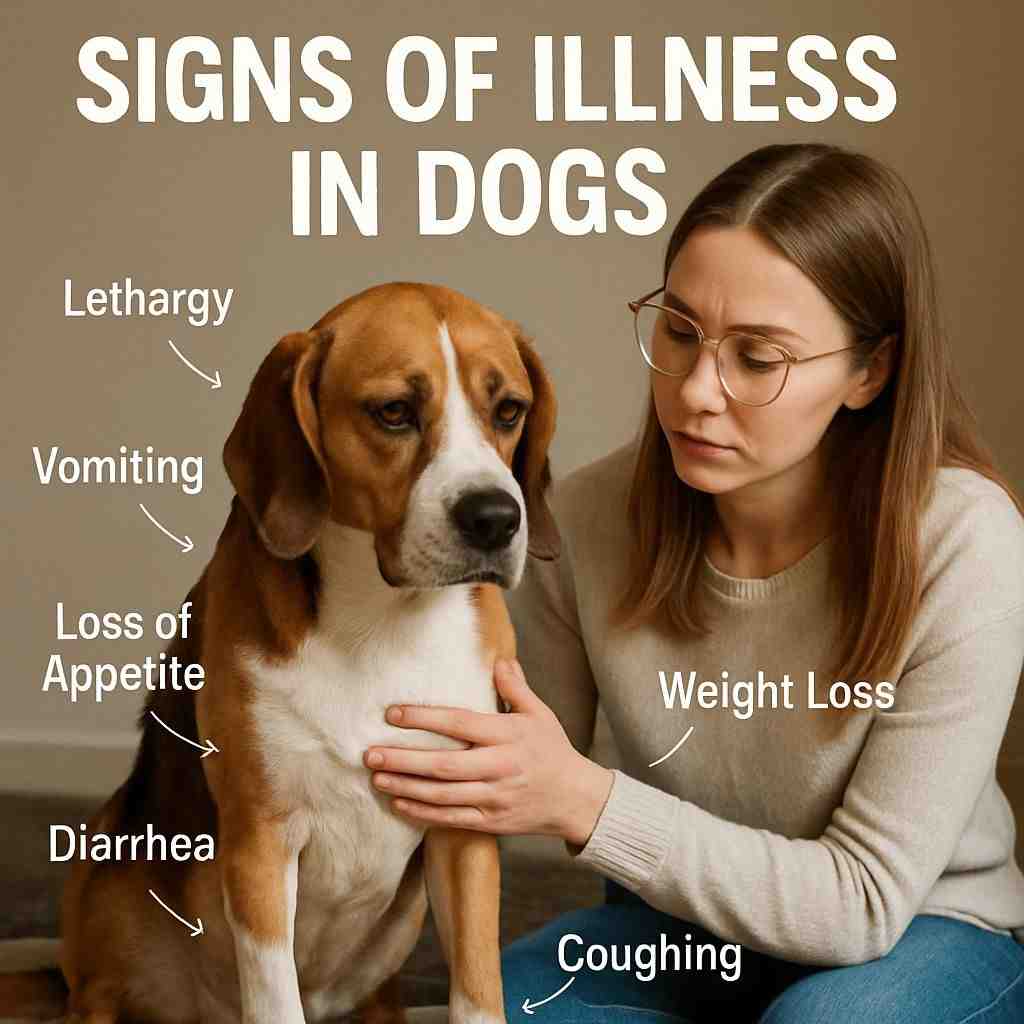
As a pet parent, I want my dog to stay healthy and active. Dogs can’t tell us about their pain with words. Instead, they express discomfort through behaviors and gestures.
A dedicated pet parent can spot signs of illness in dogs by observing closely. This ability comes from the strong bond between owner and dog. Understanding these signs of illness in dogs helps keep our furry friends thriving.
This article explores physical, behavioral, and subtle signs of illness in dogs. It includes clear explanations, real-life examples, and practical insights. You’ll feel confident keeping your dog healthy.
Why Recognizing Signs of Illness in Dogs Matters
Dogs most of the time, hide pain and discomfort, a trait from their wild ancestors. Even your pampered pup might mask signs of illness in dogs. Early detection of illness can prevent serious issues.
Catching signs of illness in dogs reduces suffering. It can even save your dog’s life. Whether it’s a minor issue or something serious, knowledge empowers you.Let’s explore the key signs of illness in dogs. We’ll cover physical and behavioral symptoms.
Physical Signs of Illness in Dogs
Physical symptoms are often the first clues of signs of illness in dogs. These are changes you can see, feel, or smell.
1. Changes in Appetite or Water Intake
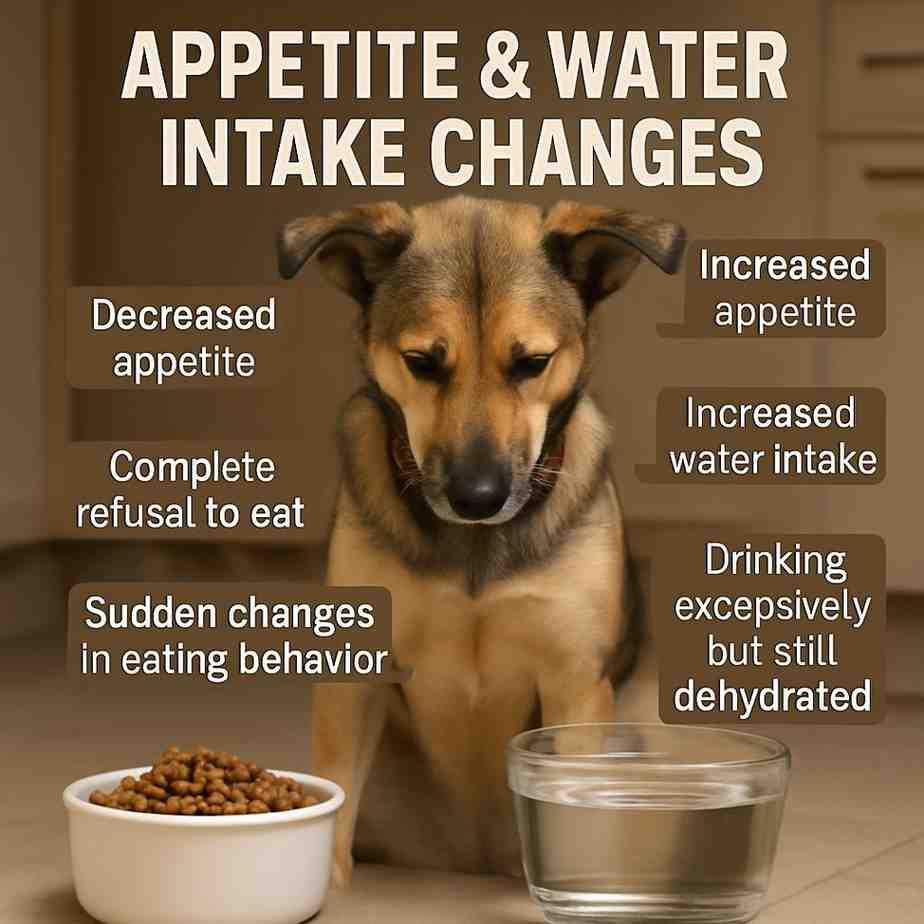
A sudden change in appetite or excessive thirst is a common sign of illness in dogs. If your dog skips meals for more than a day or drinks water excessively, it’s time to pay attention.
| Change | Why It’s a Sign of Illness | Possible Suspected Diseases/Conditions |
|---|---|---|
| Decreased appetite (anorexia) | Ill animals often feel too weak, nauseated, or in pain to eat. Indicates underlying disease. | Kidney disease, liver disease, dental problems, infections, cancer, pain, fever |
| Increased appetite (polyphagia) | Some conditions increase hunger due to hormonal changes or poor nutrient use. | Diabetes mellitus (with weight loss), Cushing’s disease, parasites, malabsorption |
| Complete refusal to eat | Severe illness, pain, or blockage can stop an animal from eating altogether. | Pancreatitis, intestinal blockage, severe infection, advanced cancer |
| Increased water intake (polydipsia) | Body demands more water due to dehydration or increased urine loss. | Diabetes mellitus, kidney disease, Cushing’s disease, pyometra, fever |
| Decreased water intake | Too weak to drink, or neurological issue impairs thirst. | Severe illness, mouth pain, brain disease, end-stage kidney or liver failure |
| Sudden changes in eating behavior | Stress, pain, or neurological changes can affect eating patterns. | Oral tumors, dental disease, foreign body, trauma, behavioral issues |
| Drinking excessively but still dehydrated | Body cannot retain water or fluids are lost quickly. | Kidney failure, Addison’s disease, severe vomiting/diarrhea, diabetes insipidus |
✅ These appetite & thirst changes are early warning signs of disease.
✅ If these persist for more than a day or two, veterinary attention is needed.
2. Vomiting or Diarrhea
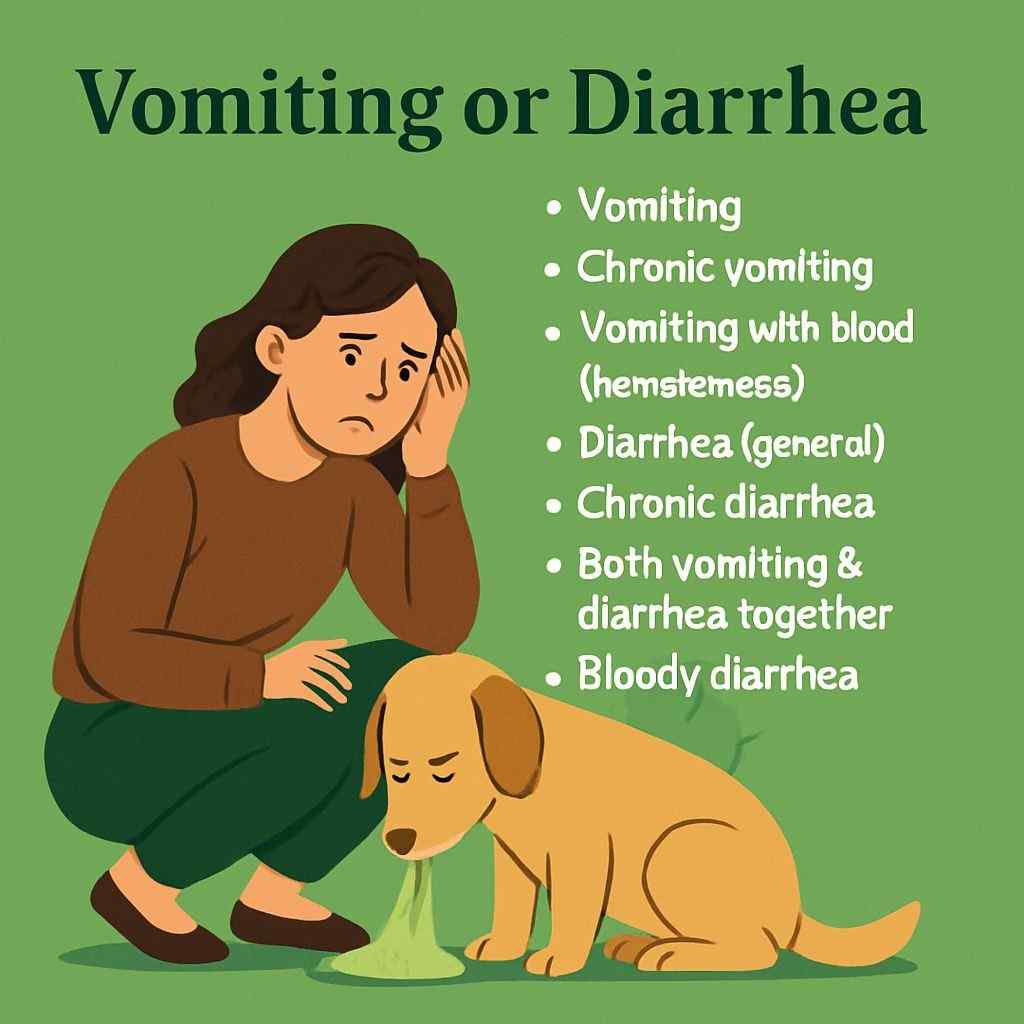
Occasional vomiting or diarrhea isn’t always alarming—dogs sometimes eat something they shouldn’t. But frequent or severe episodes are key signs of illness in dogs.
| Sign | Why It Signals Disease | Possible Causes/Diseases |
|---|---|---|
| Vomiting (general) | Forceful expulsion of stomach contents due to irritation, toxins, infection, pain, or disease. | Dietary indiscretion, infections, kidney or liver disease, toxins, foreign body,Worms infestation |
| Chronic vomiting | Ongoing or recurrent vomiting suggests a serious underlying or chronic condition. | Intestinal blockage, IBD, cancer, kidney or liver failure,Worms infestation |
| Vomiting with blood (hematemesis) | Presence of fresh (red) or digested (dark, coffee-ground) blood shows damage or bleeding in the digestive tract. | Stomach ulcers, severe gastritis, swallowed foreign body, tumors, clotting disorders, poisoning |
| Diarrhea (general) | Loose, frequent stools occur when intestines can’t absorb water due to inflammation, infection, or stress. | Parasites, infections, dietary change, IBD, stress colitis, toxins |
| Chronic diarrhea | Persistent diarrhea can lead to dehydration, weight loss, and indicates chronic disease. | Malabsorption, chronic infections, IBD, cancer, pancreas/liver problems |
| Both vomiting & diarrhea together | Suggests a more severe or systemic illness affecting the digestive system or entire body. | Parvovirus, poisoning, pancreatitis, Addison’s disease, severe infections |
| Bloody diarrhea (hematochezia or melena) | Indicates bleeding in lower (bright red) or upper (dark/tarry) intestines. | Parvovirus, hemorrhagic gastroenteritis (HGE), ulcers, parasites, clotting issues |
🩸 Blood in vomit or stool is a serious sign, indicating bleeding somewhere in the digestive tract.
🚨 Bright red blood = fresh bleeding, likely from mouth, esophagus, or stomach.
🚨 Dark, coffee-ground vomit = digested blood, usually from stomach or upper intestine.
🐾 Seek veterinary care immediately if your pet vomits blood, has bloody diarrhea, or if vomiting/diarrhea is severe, frequent, or accompanied by lethargy, pain, or collapse.
3. Lethargy or Weakness

A healthy dog is usually full of energy. Lethargy or weakness is a prominent sign of illness in dogs that shouldn’t be ignored.
| Sign | Why It Signals Disease | Possible Causes/Diseases |
|---|---|---|
| Lethargy (low energy) | When an animal is unusually tired, inactive, or uninterested in usual activities, it often means the body is fighting illness, pain, or stress. | Fever, infections, anemia, pain, heart disease, kidney or liver disease, cancer |
| Weakness (reduced strength) | Indicates impaired muscle, nerve, or energy systems; may affect walking, standing, or even breathing. | Electrolyte imbalance, low blood sugar, neuromuscular diseases, toxins, severe infections |
| Sudden onset of lethargy or collapse | Can signal a severe, life-threatening condition needing immediate attention. | Heart failure, internal bleeding, heat stroke, poisoning, Addison’s disease |
| Chronic lethargy or slow decline | Gradual loss of energy can indicate a chronic disease slowly wearing down the body. | Chronic kidney disease, cancer, arthritis, hypothyroidism, malnutrition |
| Weakness with tremors or seizures | Suggests nervous system disease or metabolic disorder affecting the brain or muscles. | Epilepsy, hypoglycemia, toxins, brain disease, electrolyte disturbances |
| Pale gums + lethargy/weakness | Suggests poor oxygen delivery or blood loss. | Anemia, shock, internal bleeding, heart disease |
🐾 Lethargy and weakness are non-specific but important warning signs.
🐾 Can result from almost any significant illness — observing other signs (like vomiting, coughing, limping, pale gums) can help narrow down the cause.
🚨 If an animal is too weak to stand, collapses, or is unresponsive — this is an emergency.
4. Skin and Coat Changes
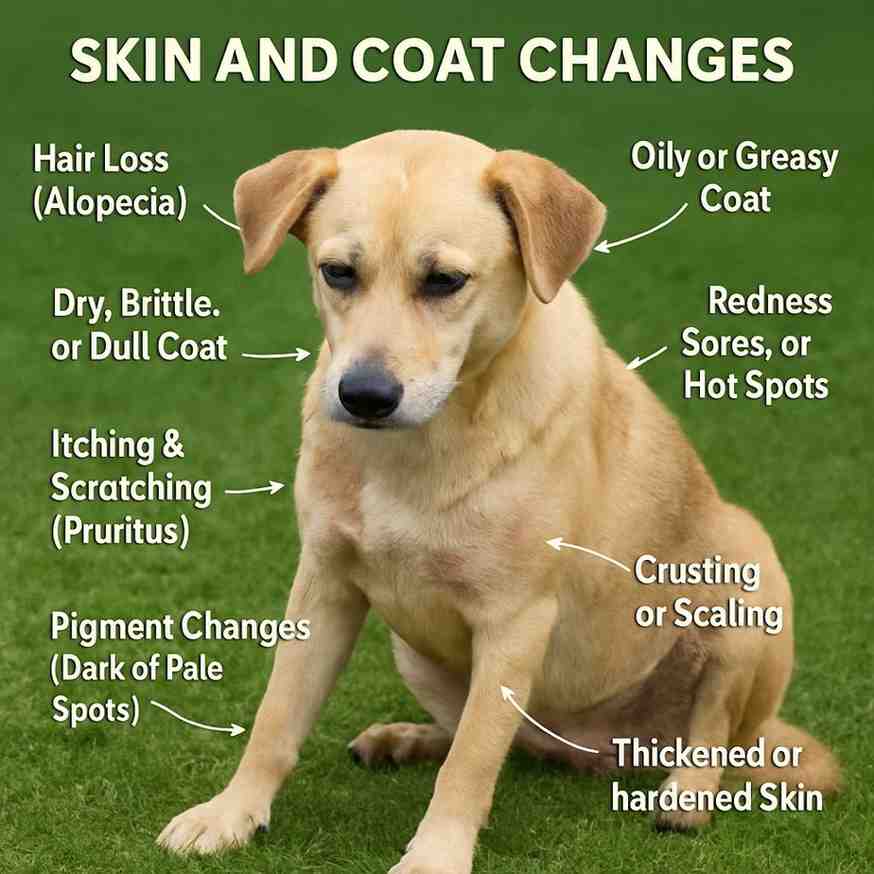
Your dog’s skin and coat reflect their health. Changes here are often signs of illness in dogs, pointing to allergies, infections, or hormonal issues.
| Change in Skin or Coat | Why It Signals Disease | Possible Causes/Diseases |
|---|---|---|
| Hair loss (alopecia) | Can result from itching, hormone imbalance, infection, or self-trauma. | Mange (mites), fleas, allergies, ringworm, hypothyroidism, Cushing’s disease |
| Dry, brittle, or dull coat | Suggests poor nutrition, chronic illness, or skin disease. | Malnutrition, kidney or liver disease, parasites, endocrine disease |
| Oily or greasy coat (seborrhea) | Overactive skin glands or secondary infection. | Allergies, hormonal diseases, chronic infections, seborrheic dermatitis |
| Itching & scratching (pruritus) | Usually due to irritation, allergies, or parasites. | Flea allergy, food allergy, atopy (environmental allergy), mange |
| Redness, sores, or hot spots | Inflammation and infection due to trauma, allergies, or underlying disease. | Bacterial/fungal infections, parasites, allergies, trauma |
| Crusting or scaling | Dead skin buildup from infection or skin disorder. | Mange, seborrhea, autoimmune skin diseases, zinc deficiency |
| Pigment changes (dark or pale spots) | Skin color changes can indicate chronic inflammation, trauma, or systemic disease. | Cushing’s disease, bruising (clotting disorders), chronic allergies |
| Thickened or hardened skin | Chronic irritation or disease may cause skin to become thick and leathery. | Chronic allergies, hormonal imbalance, repeated trauma |
| Lumps, bumps, or growths | May be benign or malignant tumors, cysts, or abscesses. | Cancer, lipomas, abscesses, warts, mast cell tumors |
🐾 Healthy skin should be smooth, without sores, and the coat should be shiny and full.
🐾 Changes in skin/coat often reflect internal problems, not just skin diseases.
🐾 Persistent hair loss, sores, itching, or lumps should be evaluated by a vet.
5. Breathing Problems
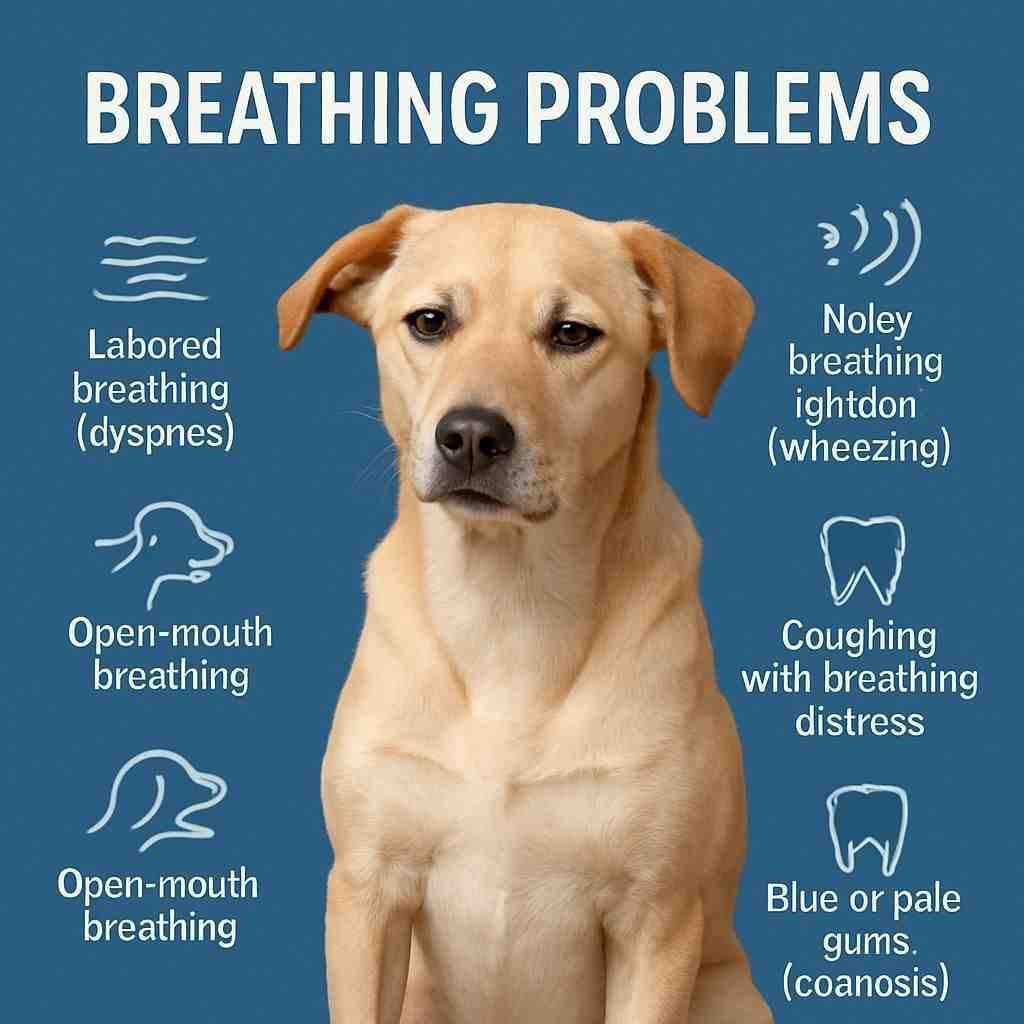
Difficulty breathing or coughing can be serious signs of illness in dogs, often linked to respiratory or heart issues.
| Sign | Why It Signals Disease | Possible Causes/Diseases |
|---|
| Rapid breathing (tachypnea) | Increased breathing rate to compensate for low oxygen or high CO₂. | Heart disease, lung disease (pneumonia, asthma), pain, heat stroke |
| Labored breathing (dyspnea) | Difficulty inhaling/exhaling shows obstruction, fluid, or lung disease. | Congestive heart failure, pleural effusion, asthma, pneumonia, tumors |
| Noisy breathing (stridor/wheezing) | Narrowed airway or obstruction causes noise when breathing. | Laryngeal paralysis, tracheal collapse, asthma, foreign body |
| Open-mouth breathing (in cats) | Emergency sign — cats normally breathe through their nose. | Severe respiratory distress, heart failure, asthma, trauma |
| Coughing with breathing distress | Irritation or fluid in lungs/airways. | Kennel cough, heart disease, pneumonia, collapsing trachea |
| Blue or pale gums (cyanosis) | Not enough oxygen in the blood — a life-threatening emergency. | Severe lung or heart disease, shock, choking |
🐾 Any breathing problem — especially with blue gums, collapse, or open-mouth breathing — needs immediate vet care.
🐾 Even mild coughing or fast breathing can signal serious underlying disease.
6. Weight Changes
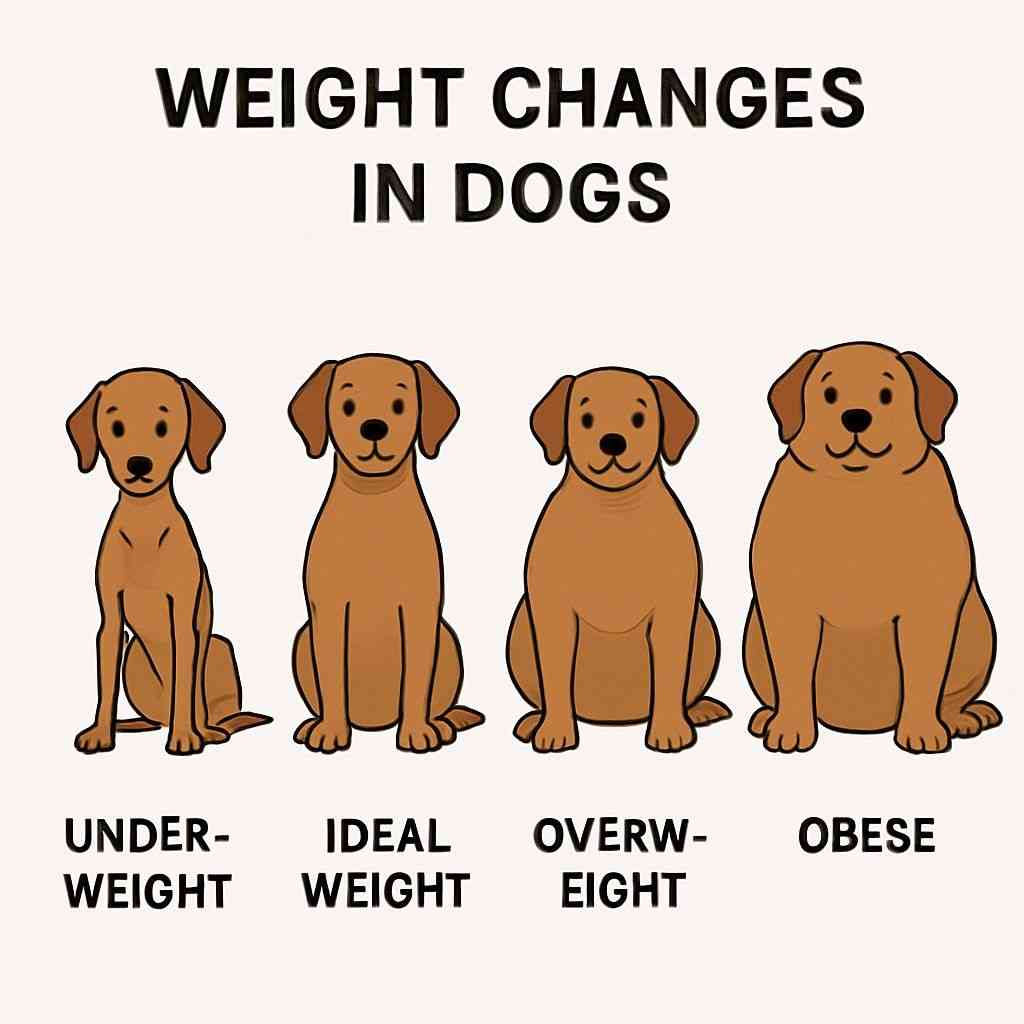
Unexpected weight loss or gain is a critical sign of illness in dogs that can indicate serious health problems.
| Sign | Why It Signals Disease | Possible Causes/Diseases |
|---|
| Unexpected weight loss | Loss of body fat or muscle due to illness, malabsorption, or increased metabolism. | Diabetes mellitus, hyperthyroidism (in cats), cancer, kidney disease, parasites, malnutrition |
| Sudden weight loss | Acute condition causing rapid tissue loss, often serious. | Severe infection, organ failure, trauma, cancer |
| Gradual weight loss | Chronic disease slowly draining the body’s reserves. | Chronic kidney disease, cancer, intestinal disease, dental disease |
| Weight gain (obesity) | Excess calories, low activity, or hormonal problems. | Overfeeding, hypothyroidism, Cushing’s disease, arthritis (less activity) |
| Abnormal fat distribution (pot-belly) | Fluid accumulation, muscle loss, or organ enlargement can look like weight gain. | Cushing’s disease, ascites (fluid), liver disease, tumors |
| Muscle wasting despite normal weight | Muscle breakdown while fat remains can indicate systemic disease. | Cancer, chronic illness, nerve disease, cachexia |
🐾 Weight changes often happen gradually and may go unnoticed — regular monitoring is crucial.
🐾 Unexplained or sudden weight loss, or abnormal weight gain with symptoms like lethargy or swelling, should be checked by a vet.
7.Eye and Mouth Signs of Illness in Dogs
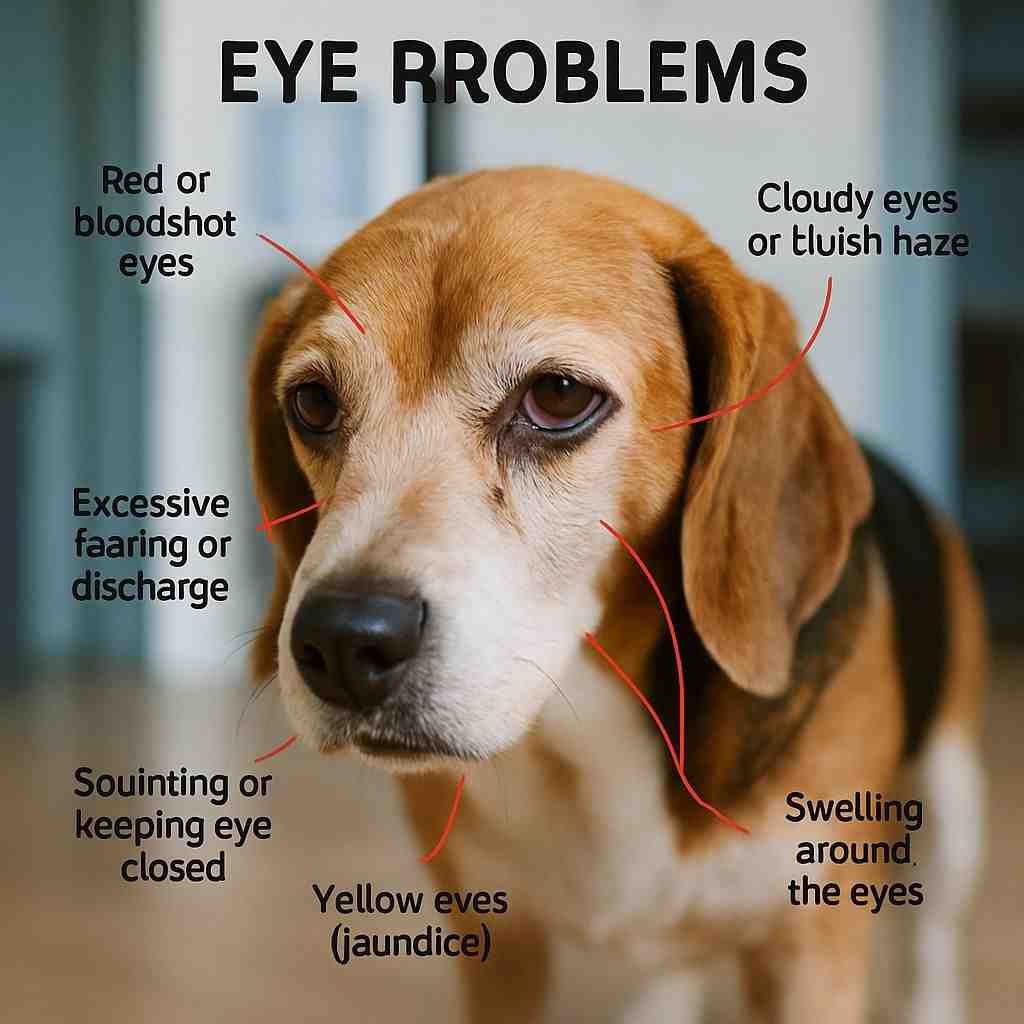
| Eye Sign | What it Indicates | Possible Causes/Diseases |
|---|---|---|
| Red or bloodshot eyes | Inflammation, infection, or increased pressure. | Conjunctivitis, glaucoma, uveitis, allergies |
| Cloudy eyes or bluish haze | Loss of clarity in the eye, vision problems. | Cataracts, glaucoma, corneal disease, nuclear sclerosis |
| Excessive tearing or discharge | Irritation or infection of the eyes. | Conjunctivitis, dry eye, corneal ulcer, foreign body |
| Squinting or keeping eye closed | Pain or discomfort in the eye. | Corneal injury, ulcer, foreign body, infection |
| Swelling around the eyes | Allergy, trauma, or infection. | Abscess, insect bite, orbital infection |
| Yellow eyes (jaundice) | Liver disease or breakdown of red blood cells. | Hepatic disease, hemolytic anemia |
Mouth Sign
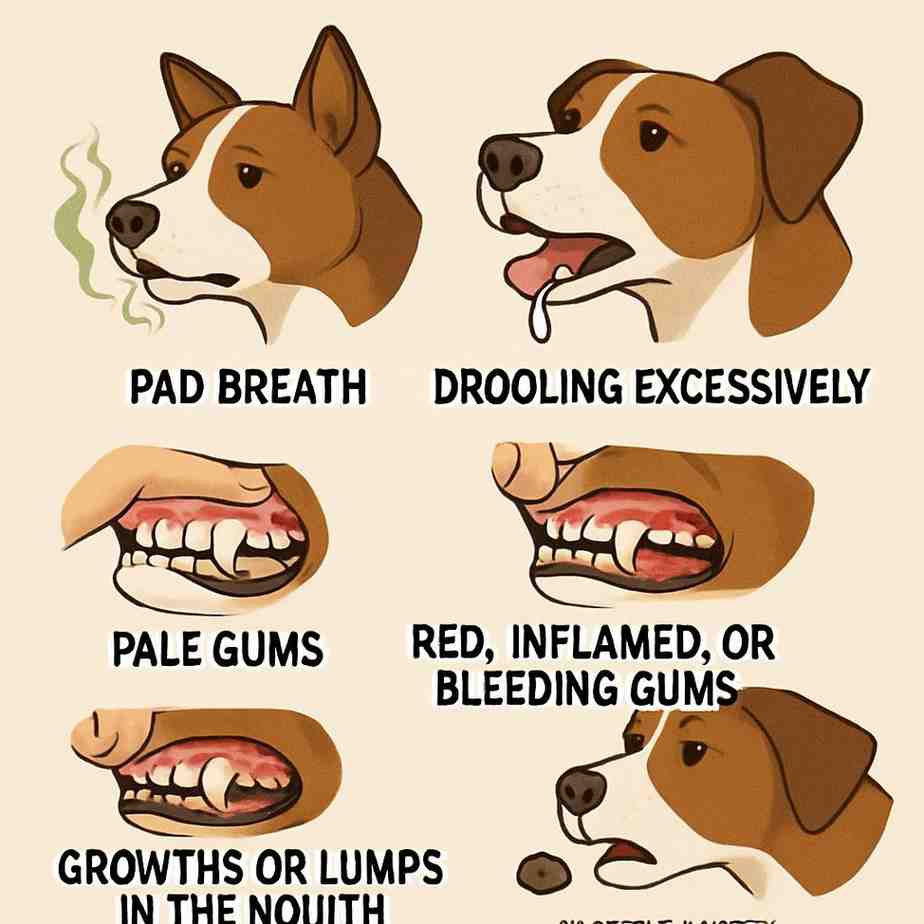
| Mouth Sign | What it Indicates | Possible Causes/Diseases |
|---|---|---|
| Bad breath (halitosis) | Bacterial overgrowth, dental or systemic disease. | Dental disease, kidney disease, diabetes |
| Drooling excessively (ptyalism) | Pain, nausea, oral injury, or toxins. | Dental problems, nausea, foreign body, poisoning,Rabies |
| Pale gums | Poor oxygenation or blood loss. | Anemia, shock, internal bleeding, heart disease |
| Red, inflamed, or bleeding gums | Inflammation or infection in the mouth. | Gingivitis, periodontal disease, toxins |
| Growths or lumps in the mouth | Tumors or inflammation. | Oral cancer, abscess, benign masses |
| Difficulty eating or chewing | Pain or discomfort in mouth or throat. | Dental disease, oral injury, neurological issue |
8. Ear-Related Illness Signs in Dogs
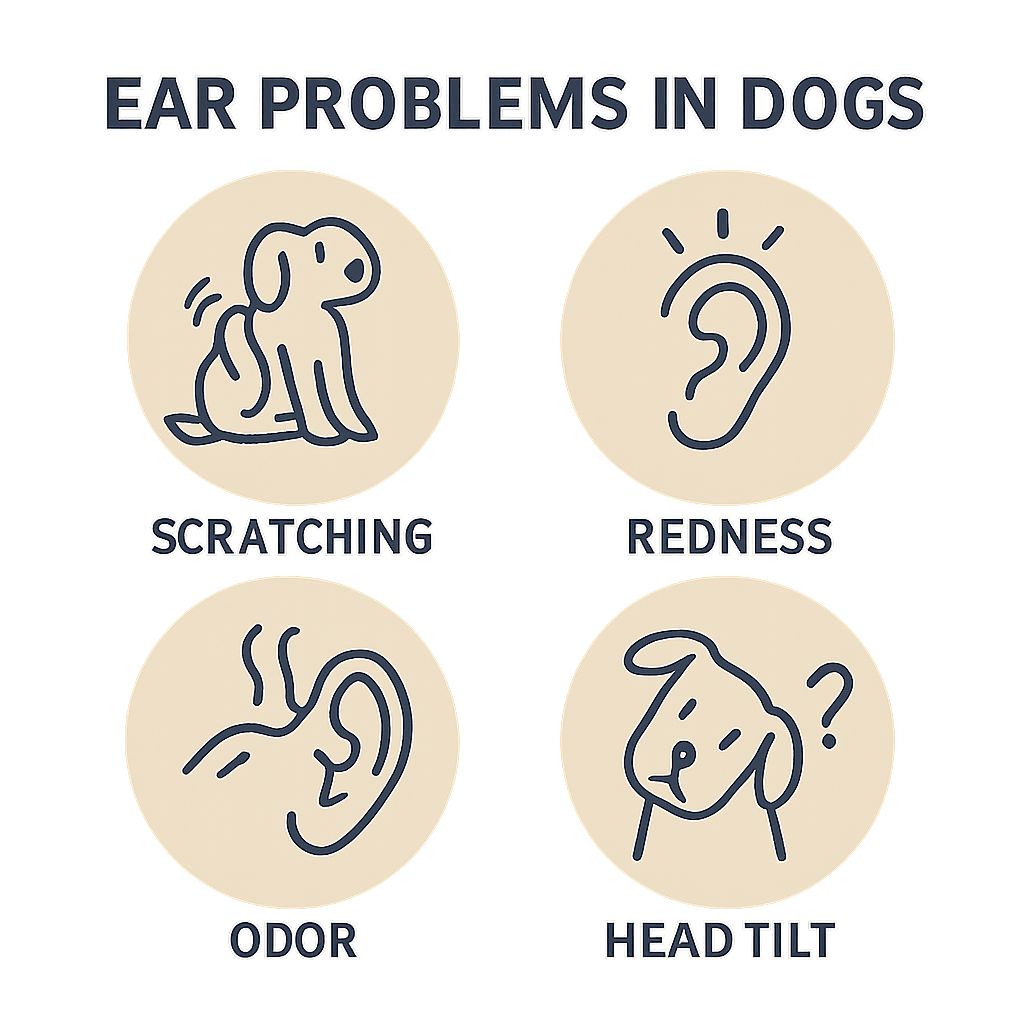
| Sign | What it Indicates | Possible Causes/Diseases |
|---|---|---|
| Head shaking or constant scratching at ears | Irritation, discomfort, or pain in the ear. | Ear infection (bacterial/yeast), ear mites, foreign body, allergy |
| Redness and swelling inside the ear | Inflammation or infection of the ear canal. | Otitis externa (outer ear infection), allergic reaction |
| Foul smell from the ears | Overgrowth of bacteria or yeast. | Chronic otitis, ear canal infection, trapped moisture |
| Dark brown, black, or yellow discharge | Infection, mites, or wax buildup. | Ear mites (dark crumbly debris), yeast or bacterial infection |
| Tilting head to one side | Pain, balance problem, or inner ear disease. | Inner ear infection (otitis interna), vestibular disease |
| Loss of balance, circling, or falling over | Inner ear or neurological problem. | Vestibular syndrome, severe inner/middle ear infection |
| Ear hematoma (swollen, soft ear flap) | Ruptured blood vessels from trauma (usually from shaking or scratching). | Underlying ear infection, mites, allergies |
| Crusts, sores, or hair loss around ear flap | Skin disease involving the ear area. | Mange, allergies, sunburn, autoimmune skin disease |
🐾 Eyes, Ears and mouth are windows into your dog’s health — changes here often reflect pain or systemic disease.
🐾 Any persistent redness, discharge, swelling, or difficulty eating should be checked by a vet.
9.Dog Poop Colors & Consistency —signs of illness in dogs
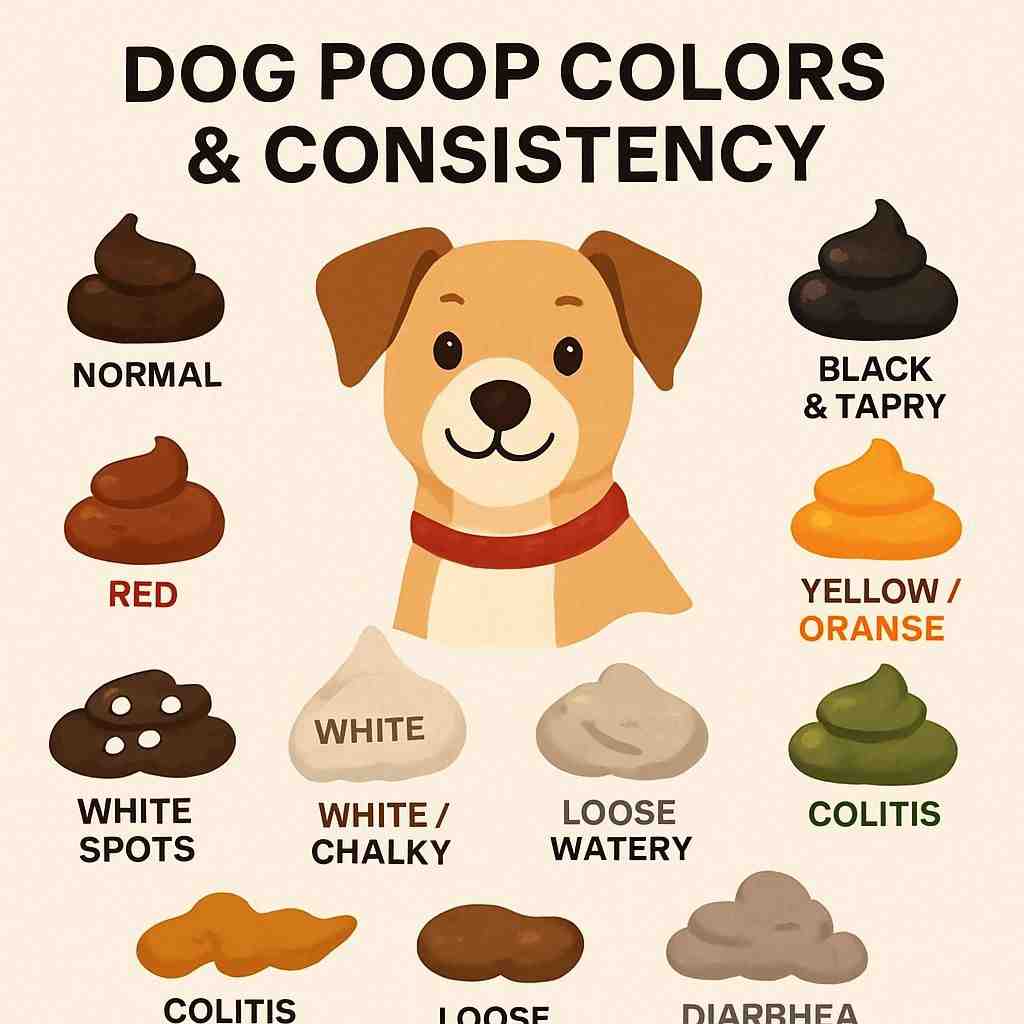
| Poop Color & Consistency | What it means | Possible diseases / conditions | Other signs to look for |
|---|---|---|---|
| Normal (chocolate brown, firm but moist) | Healthy digestion | — | Bright, active, normal appetite |
| Black & tarry (melena) | Bleeding in upper GI tract | Gastric ulcer, tumor, coagulopathy | Vomiting, pale gums, weakness |
| Red streaks / fresh blood | Bleeding in lower GI (colon, rectum) | Colitis, parasites, rectal injury | Straining, pain while defecating, mucus in stool |
| Yellow / orange | Liver or biliary problem, rapid transit | Liver disease, gallbladder disease, pancreatitis | Jaundice, vomiting, lethargy |
| Grey / clay-colored, greasy | Lack of bile, maldigestion | Exocrine pancreatic insufficiency (EPI), bile duct obstruction | Weight loss, ravenous appetite, dull coat |
| Green | Eating grass, bile issues, intestinal infection | Dietary indiscretion, parasitism, giardiasis | Vomiting, diarrhea, lethargy |
| White spots / segments | Tapeworm segments (proglottids) | Tapeworm infestation | Scooting, licking anus |
| White or chalky, hard | Excessive calcium (bones) | Too many bones in diet | Constipation, straining |
| Loose / watery (diarrhea) | Intestinal upset, infections, parasites | Parvovirus, giardia, dietary indiscretion | Dehydration, vomiting, lethargy |
| Soft & shiny / greasy | Poor fat absorption | EPI, chronic pancreatitis | Weight loss despite eating |
| Mucus-covered | Colonic irritation or inflammation | Colitis, stress, parasites | Straining, bloody stool, pain |
✅ Black, tarry stool (melena) → Dog with gastric ulcer due to NSAID toxicity. Signs: vomiting, weakness, pale gums.
✅ Yellow, soft stool → Dog with liver disease (hepatitis). Signs: jaundice (yellow gums), poor appetite, vomiting.
✅ Greasy, light-colored stool with weight loss → Dog with EPI. Signs: very hungry but losing weight, dull coat.
✅ Red, mucus-covered stool → Dog with colitis from stress or whipworm. Signs: straining, discomfort, some fresh blood.
✅ Diarrhea & vomiting with lethargy → Dog with parvovirus. Signs: foul-smelling bloody diarrhea, dehydration, fever.
Dog Urine Color & Consistency — Diagnostic Guide
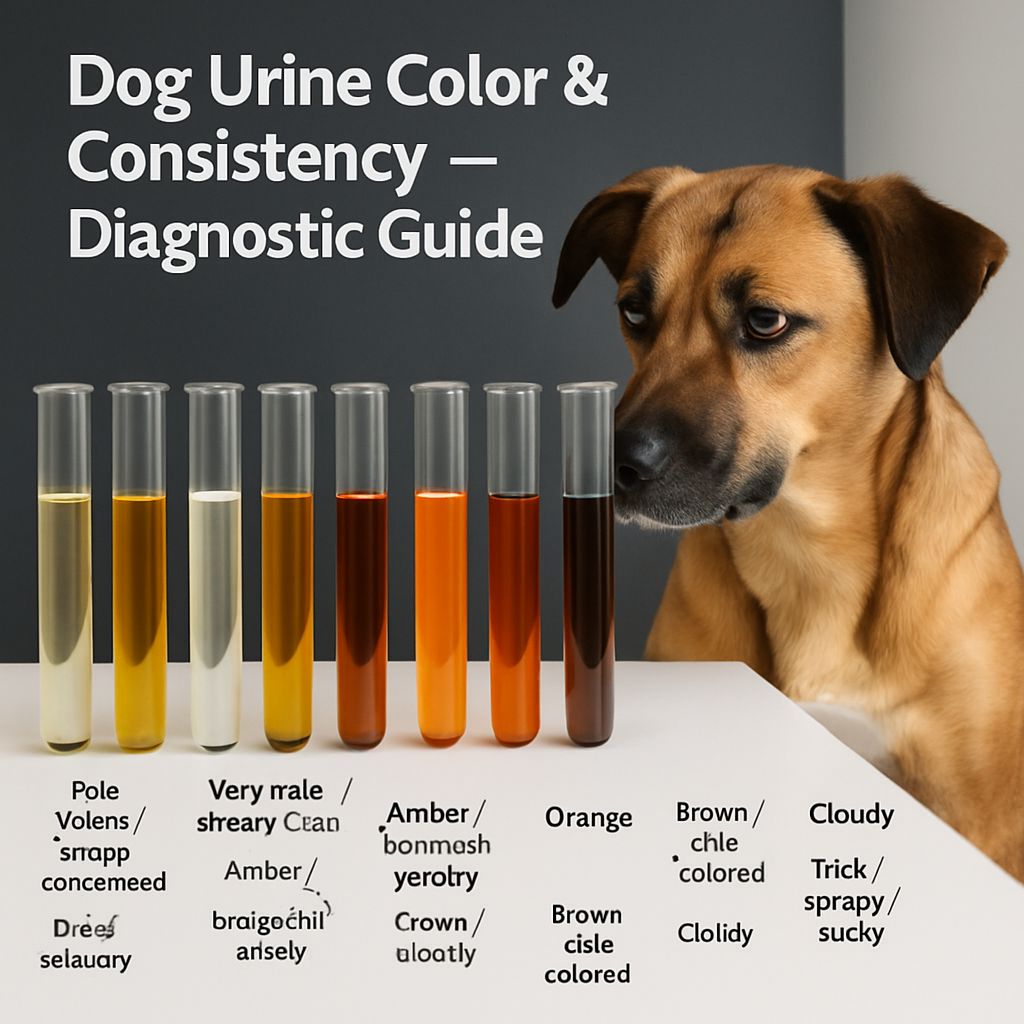
| Urine Color & Consistency | What it suggests | Possible diseases / conditions | Other signs to look for |
|---|---|---|---|
| Pale yellow / straw-colored, clear | Normal hydration & kidney function | — | Active, good appetite, no signs of illness |
| Dark yellow / concentrated | Dehydration, reduced water intake | Early kidney disease, fever, heat stress | Lethargy, dry gums, skin tenting |
| Very pale / almost clear | Overhydration, dilute urine | Diabetes insipidus, diabetes mellitus, chronic kidney disease | Increased drinking & urination, weight loss |
| Amber / brownish-yellow | Liver disease, muscle breakdown (myoglobinuria) | Hepatitis, leptospirosis, trauma | Jaundice, vomiting, weakness |
| Red / pink / bloody (hematuria) | Blood in urine | UTI, bladder stones, trauma, tumor | Straining to urinate, frequent urination, pain |
| Orange | Bilirubin in urine | Liver or bile duct disease, hemolysis | Yellow gums/skin, vomiting, poor appetite |
| Brown / cola-colored | Severe muscle damage or old blood | Myopathy, heat stroke, IMHA | Weakness, collapse, dark stools |
| Cloudy | Infection, crystals, pus (pyuria) | UTI, crystalluria, prostatitis | Frequent, painful urination, licking genitals |
| Thick / syrupy / sticky | Sugar or protein in urine | Diabetes mellitus, severe proteinuria | Increased thirst & urination, weight loss |
| Foul-smelling | Infection, high bacterial load | UTI, pyelonephritis | Fever, discomfort, lethargy |
📋 Example scenarios:
✅ Dark yellow, scant urine → Dog with dehydration from heat stroke. Signs: panting, dry gums, weakness.
✅ Red or pink urine → Dog with bladder stones. Signs: straining, crying when urinating, frequent squatting.
✅ Brown, cola-like urine → Dog with muscle damage after trauma or heatstroke. Signs: weakness, collapse, dark stool.
✅ Cloudy & foul-smelling urine → Dog with UTI. Signs: frequent urination, licking genitals, discomfort.
✅ Pale, copious urine → Dog with diabetes mellitus. Signs: drinking & urinating a lot, weight loss, cataracts.
Behavioral Signs of Illness in Dogs
Behavioral changes can be just as revealing as physical symptoms when identifying signs of illness in dogs. Dogs often show discomfort through shifts in personality or habits.
1. Increased Aggression or Irritability
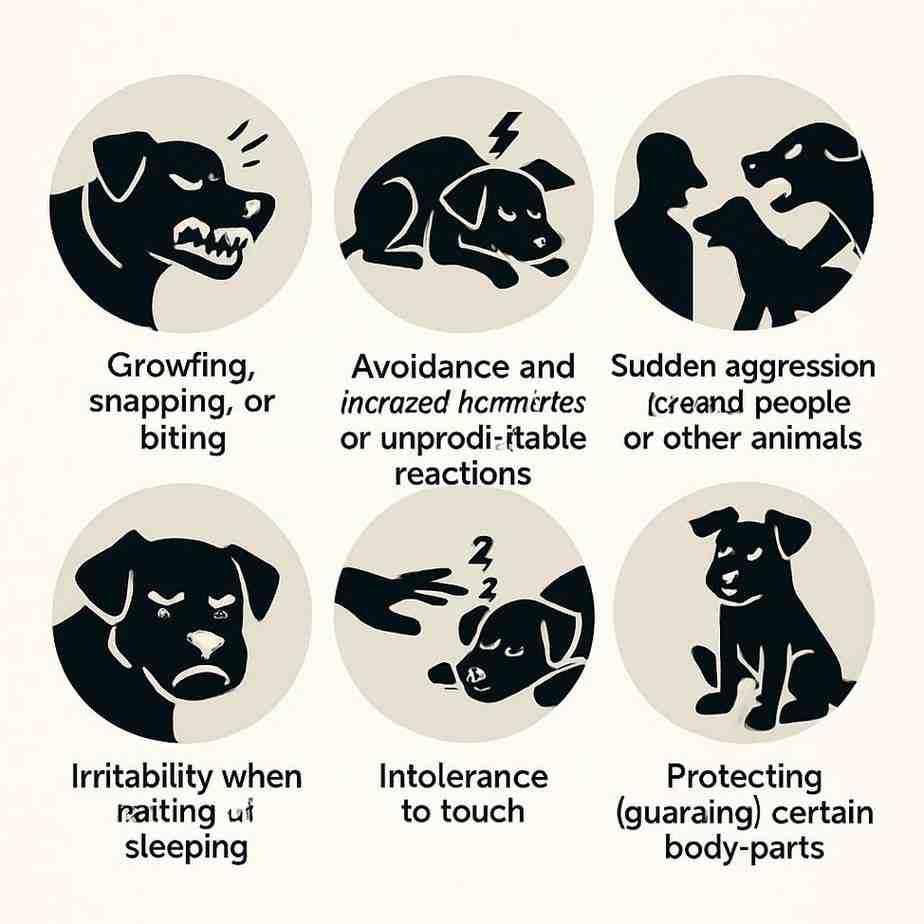
If your normally friendly dog starts snapping or growling, it’s a potential sign of illness in dogs, likely due to pain.
| Change in Behavior | Why It Happens (Effect on Dog) | Possible Causes/Diseases |
|---|
| Growling, snapping, or biting | Pain, fear, or discomfort may make the dog more defensive or reactive. | Pain from injury, arthritis, dental disease, ear infection |
| Avoidance and intolerance to touch | Dog becomes irritable because handling causes discomfort or fear. | Skin infections, wounds, joint pain, internal pain |
| Sudden aggression toward people or other animals | May signal neurological or hormonal changes affecting temperament. | Brain disease, rabies, thyroid disease, tumors |
| Irritability when resting or sleeping | Resting becomes disturbed due to discomfort or anxiety. | Pain, arthritis, anxiety, cognitive dysfunction (in older dogs) |
| Protecting (guarding) certain body parts | The dog becomes aggressive when a painful area is touched. | Fractures, soft tissue injury, abscess, internal pain |
| Increased fearfulness or unpredictable reactions | Illness or reduced senses (vision/hearing) can make dogs feel vulnerable and aggressive. | Neurological disease, sensory loss, cognitive decline |
🐾 Sudden aggression or irritability is not just a behavior problem — it can be a medical issue.
🐾 Pain and fear are the most common reasons for aggression in an otherwise friendly dog.
🐾 Dogs showing these changes should be checked by a veterinarian to rule out hidden pain or disease.
2. Excessive Vocalization
Whining, howling, or barking more than usual can be signs of illness in dogs, indicating distress.
| What it Means | When a pet barks, meows, howls, or cries more than usual. |
|---|
| Why it Happens | Pain, anxiety, confusion, or seeking attention due to discomfort or illness. |
| Possible Causes | Pain (arthritis, injury), cognitive dysfunction (senility in older pets), anxiety or stress, vision or hearing loss, discomfort (e.g., needing to urinate, hungry), hyperthyroidism (in cats). |
| Key Point | Sudden or persistent loud vocalizing — especially if unusual for that animal — should be checked by a vet. |
- What to look for: Unprovoked whining or crying, especially at night.
- Possible causes: Pain, anxiety, or cognitive dysfunction in older dogs.
- Tip: Note when the vocalization happens and discuss it with your vet.
3. Changes in Activity Levels
A dog that stops playing or becomes overly clingy may show signs of illness in dogs.
| What it Means | The animal becomes much more active or much less active than normal. |
|---|
| Why it Happens | Changes in energy may indicate illness, pain, hormonal problems, or behavioral issues. |
| Possible Causes | Decreased activity (lethargy): pain, infections, heart disease, anemia, depression. Increased activity (restlessness): anxiety, discomfort, hyperthyroidism (in cats), pain, itching, hormonal disorders. |
| Key Point | Both hyperactivity and lethargy can indicate disease — especially if sudden or severe. |
- What to look for: Avoiding exercise, hiding, or following you everywhere.
- Possible causes: Pain, anxiety, or organ dysfunction.
- Case Study: Chloe, a 5-year-old Cocker Spaniel, stopped jumping on the couch and hid under the bed, a behavioral sign of illness in dogs. Her vet found a urinary tract infection, cleared with antibiotics.
4. House Soiling
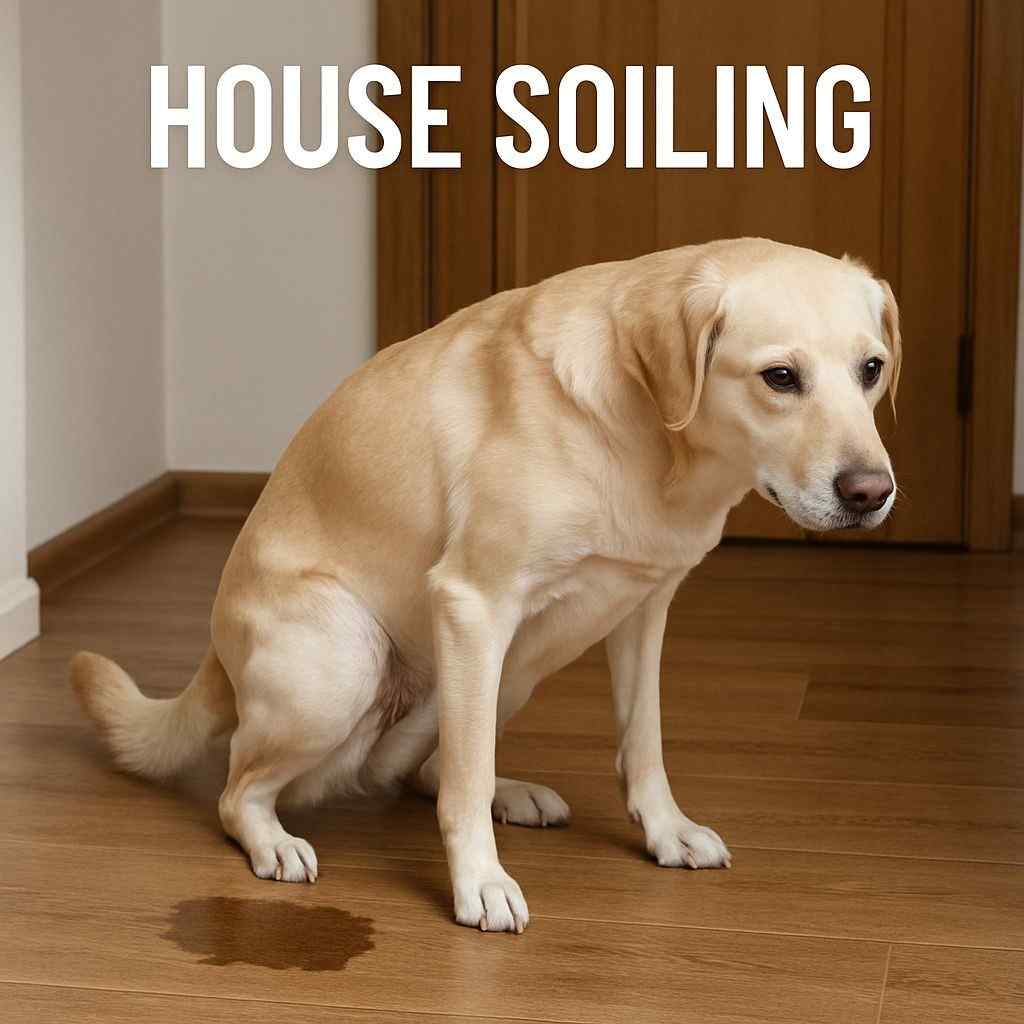
If a house-trained dog starts having accidents, it’s often a sign of illness in dogs, not a training issue.
| What it Means | The animal urinates or defecates inside the house or outside of their usual litter box/toilet area. |
|---|
| Why it Happens | Illness, pain, inability to hold urine/stool, or behavioral stress. |
| Possible Causes | Urinary tract infection, kidney disease, bladder stones, diabetes (increased urination), arthritis (difficulty reaching litter box or going outside), cognitive dysfunction in older pets, marking behavior. |
| Key Point | House soiling often points to a medical problem first, not just a behavior issue — a vet exam is recommended. |
Highly Suggestive Signs of Specific Diseases in Dogs
| Sign (Symptom) | Specific Disease Strongly Suggested | Explanation |
|---|---|---|
| “Cherry eye” (red gland protruding at inner corner of eye) | Prolapsed nictitans gland (cherry eye) | The tear gland of the third eyelid becomes displaced and visibly swollen. |
| “Scooting” on the ground with licking rear | Impacted or infected anal glands | Dogs drag bottom due to irritation from full or infected anal sacs. |
| “Goose-honk” cough with excitement or pressure on neck | Collapsing trachea | Classic honking cough triggered by excitement or pulling on collar. |
| Bilateral symmetrical hair loss (esp. flanks) with dark skin and pot-belly | Cushing’s disease (hyperadrenocorticism) | Hormonal changes lead to thin skin, hair loss, and abdominal fat deposition. |
| Acute, painful, non-weight bearing rear leg with swelling below knee | Cranial cruciate ligament rupture (CCL tear) | A sudden injury to the stifle ligament, common in active or overweight dogs. |
| Blue gums/tongue during exercise or rest | Severe heart disease or lung disease | Cyanosis occurs when oxygenation is critically low. |
| Open-mouth breathing or panting in a cat (not normal in cats) | Severe respiratory distress | (Note: more specific to cats, but in dogs with extreme distress can indicate emergency.) |
| Sudden, unilateral facial droop and head tilt | Vestibular disease (or stroke-like syndrome) | Loss of balance with a head tilt, falling to one side. |
| Nasal discharge + reverse sneezing + facial swelling (esp. on one side) | Nasal tumor or fungal infection | Often one-sided, progressive obstruction or bleeding from the nose. |
| Intensely itchy skin, hair loss at tail base and back, worse in summer | Flea allergy dermatitis | Hypersensitivity to flea saliva — classic “flea triangle.” |
| Yellow eyes, gums, or skin (jaundice) | Liver disease or hemolytic anemia | Bilirubin buildup causes the yellow color. |
| White, chalky stools or lack of pigment in stool | Bile duct obstruction or severe liver disease | Lack of bile pigment reaching intestine. |
| Excessive drinking & urination + weight loss + cataracts (in dogs) | Diabetes mellitus | High blood sugar leads to these classic signs. |
| Painful, enlarged abdomen with unproductive retching & distress | Gastric dilatation-volvulus (GDV/bloat) | A life-threatening emergency in deep-chested dogs. |
| Unilateral bulging of the eye (exophthalmos) with difficulty closing eyelids | Orbital abscess or retrobulbar tumor | Behind-eye pressure pushes the eye outward. |
| Chronic bad breath + loose/missing teeth + red gums | Advanced periodontal disease | Dental disease progressing to bone and tooth loss. |
| Hemorrhages on skin/mucosa + spontaneous bleeding | Platelet disorders or clotting factor deficiency (e.g., ITP, rodenticide poisoning) | Low platelets or clotting failure leads to petechiae and ecchymoses. |
| Coughing blood (hemoptysis) + weight loss + exercise intolerance | Heartworm disease | Adult worms in lungs and heart cause lung damage and heart failure. |
| Neck pain & reluctance to move neck, crying out when lifted | Cervical disc herniation | Common in Dachshunds & other breeds — pressure on spinal cord. |
✅ These signs are strongly suggestive but not absolute proof — definitive diagnosis requires a veterinarian’s exam and tests.
✅ Some diseases can mimic others, so lab work, imaging, or biopsy may still be needed to confirm.
✅ If you see any of these signs in your dog, seek veterinary care promptly, especially for emergency signs (blue gums, bloat, seizures, collapse).
When to See a Vet for Signs of Illness in Dogs
Not every sign of illness in dogs requires an immediate vet visit, but some demand quick action.
- Emergency (Act Now): Seizures, collapse, severe bleeding, or difficulty breathing.
- Urgent (Within 24 Hours): Persistent vomiting, diarrhea, or refusal to eat.
- Monitor (Call Vet if Persistent): Mild lethargy, occasional limping, or minor skin changes.
Case Study: When Rusty, a 4-year-old Boxer, collapsed after a walk, his owner rushed him to the vet. Tests revealed a heart condition called dilated cardiomyopathy, a serious sign of illness in dogs. Early intervention with medication extended Rusty’s life by years.
How to Monitor Your Dog’s Health for Signs of Illness
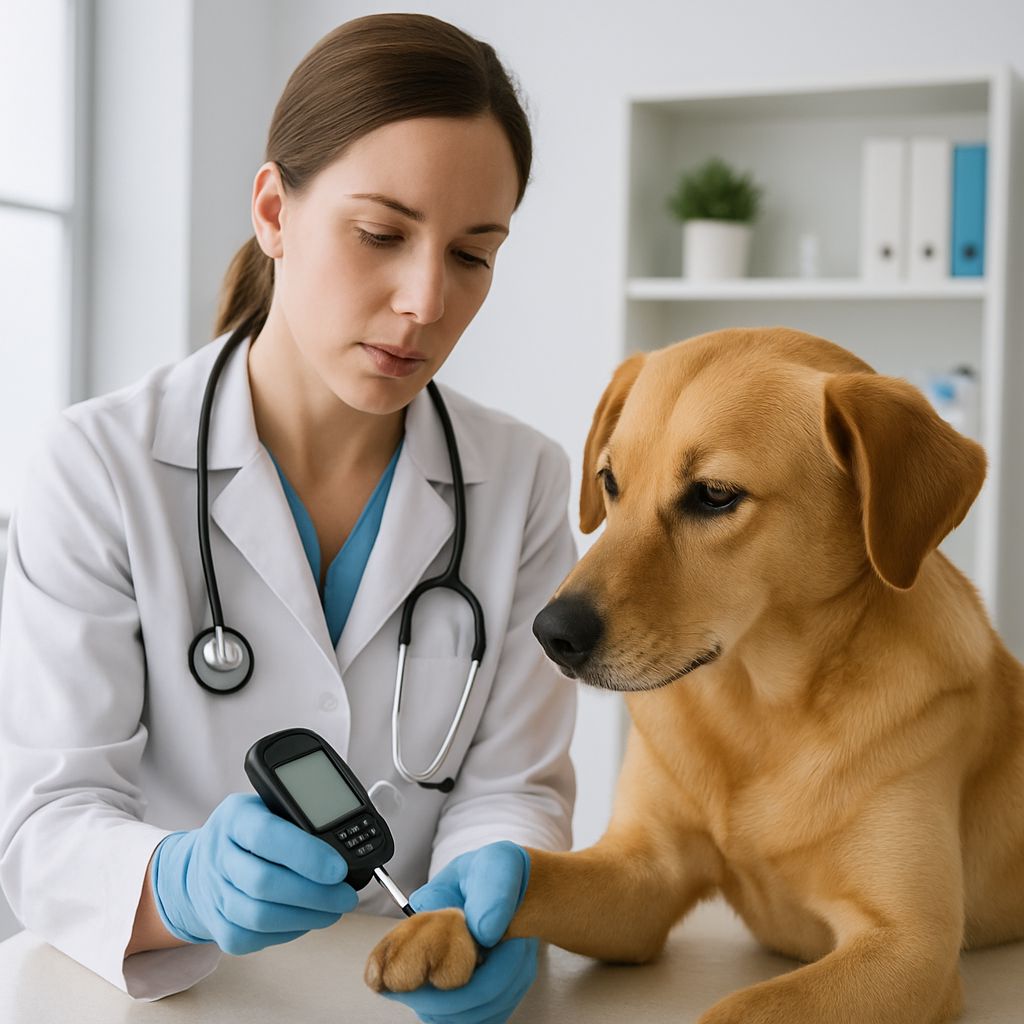
Being proactive can help you catch signs of illness in dogs early. Here’s how:
- Regular Checkups: Schedule annual or bi-annual vet visits, especially for senior dogs.
- Know Your Dog’s Normal Activities: Track their weight, eating habits, and behavior to spot signs of illness in dogs.
- Regular Grooming Checks: Look for skin issues, lumps, or parasites while brushing.
- Proper Dental Care: Brush your dog’s teeth regularly to prevent dental disease, a common cause of signs of illness in dogs.
Tip: Keep a journal of your dog’s health to share with your vet. It can help diagnose signs of illness in dogs faster.
Scientific Insights into Signs of Illness in Dogs
Research shows that early detection of signs of illness in dogs significantly improves outcomes. A 2023 study in Veterinary Medicine found that 70% of dogs with chronic conditions like kidney disease showed subtle signs (e.g., increased thirst) months before severe symptoms appeared. Regular bloodwork and urinalysis can detect signs of illness in dogs like diabetes or liver disease before symptoms become obvious. For example, elevated liver enzymes in a blood test can signal liver disease, even if your dog seems fine.
Another study from the Journal of Veterinary Internal Medicine (2024) highlighted that behavioral changes, like aggression or withdrawal, are often the first signs of illness in dogs related to pain. This underscores the importance of watching for both physical and behavioral clues.
Conclusion: Be Your Dog’s Health Advocate
Your dog relies on you to notice signs of illness in dogs. By paying attention to physical symptoms like vomiting or lethargy and behavioral changes like aggression or hiding, you can catch health issues early. Regular vet visits, a keen eye, and knowledge of signs of illness in dogs go a long way in keeping your dog healthy. Whether it’s a minor infection or a serious condition, acting quickly can make all the difference. So, take a moment today to observe your dog. Are they eating normally? Acting like themselves? If you spot any signs of illness in dogs, trust your instincts and reach out to your vet. Your furry friend will thank you with wags and cuddles for years to come.
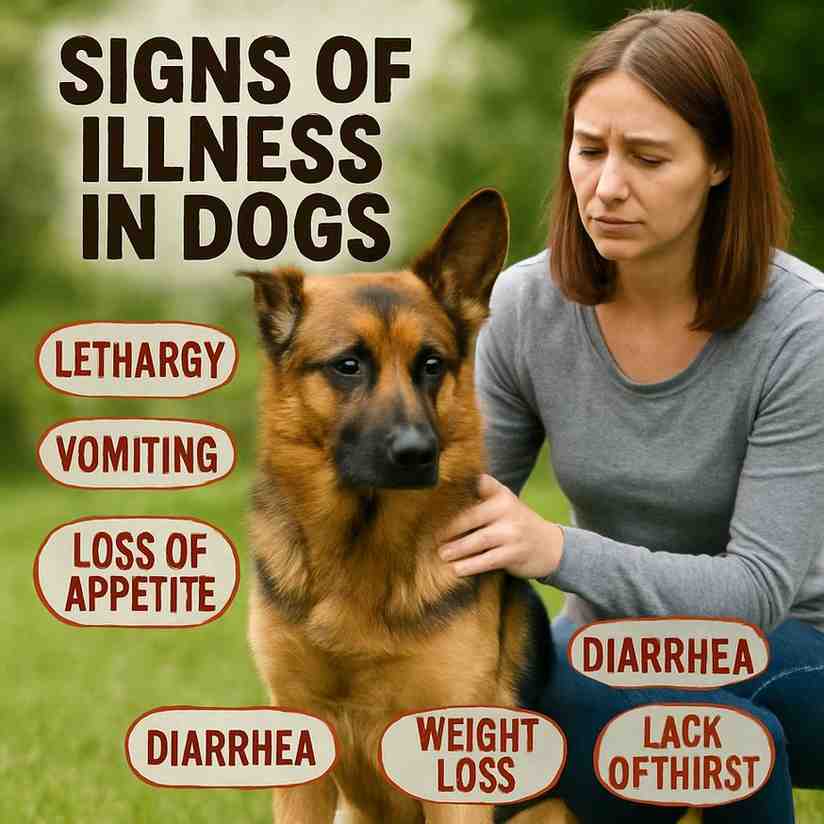
2 thoughts on “Signs of Illness in Dogs: How to Detect Early and Act Fast”